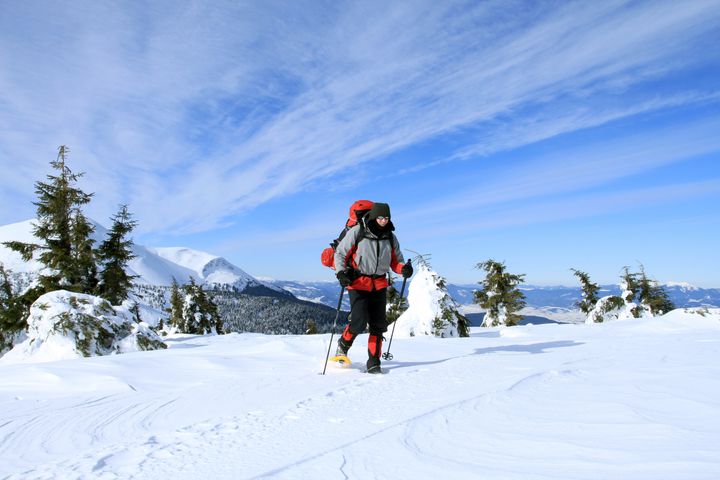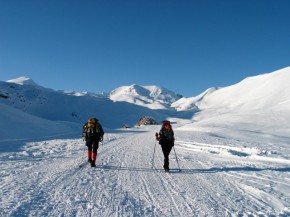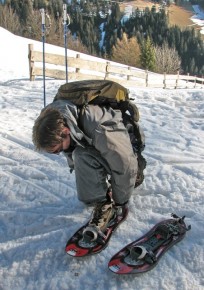
For outdoor enthusiasts who enjoy the unique experience that traditional winter sports have to offer, snowshoeing is the perfect sport. Add in the magnificent natural beauty and perfect snow-covered terrain of the Dolomites, and you've got the perfect setting for an unforgettable snowshoeing adventure.
 For many people, the turn of seasons from fall to winter means exciting outdoor adventures and beautiful natural experiences. One of the most popular cold-weather activities enjoyed by outdoor enthusiasts is snowshoeing, and there is truly no better place to partake than in the breathtaking Dolomites when this pristine mountain landscape is blanketed with snow.
For many people, the turn of seasons from fall to winter means exciting outdoor adventures and beautiful natural experiences. One of the most popular cold-weather activities enjoyed by outdoor enthusiasts is snowshoeing, and there is truly no better place to partake than in the breathtaking Dolomites when this pristine mountain landscape is blanketed with snow.
Snowshoes are a type of footwear that attach to your shoes to make travel over snow easier. Developed centuries ago by farmers and hunters, they were originally used as a practical means to accomplish daily activities during the winter months and not be inhibited by inclement weather. Traditional snowshoes were fashioned from hardwood frames and rawhide laces. Over the years, however, the footwear has been redesigned to be much lighter weight and practical, and the primary use has changed from utilitarian necessity to an outdoor recreational activity that can be enjoyed by the whole family.
Today's snowshoes are made with modern materials: some employ an aluminum or stainless steel tubing, and replace the rawhide laces with a neoprene, nylon or polypropylene decking; others are made using plastics and injection molding to make a lighter, more durable shoe. Today's snowshoes also enjoy a hinged binding system, where the ball of the foot is attached to the snowshoe while the heel is left free. A series of straps are used to fasten the foot to the snowshoe, and cleats located on the bottom of the shoe bite into the snow and ice to provide traction and help snowshoers travel up hill without sliding back down.
Snowshoes work by distributing the weight of the person over a surface area much greater than the individual's footprint. This results in "flotation," preventing the person's foot from sinking completely into the snow (or "post-holing"). In the past snowshoes looked a lot like an elongated tennis racket, an oval hoop with a tail. Today's snowshoes still feature the rounded toe and larger area under the forefoot, but the "tail" tends to be wider and aid in "floatation" more than in the past.
In addition to distributing weight, snowshoes are generally raised at the toe for maneuverability (so they don't "nose dive" into the snow with each step). It is also important that they not accumulate snow with each step. In the past, a open latticework deck provided a way for the snow to fall to the ground between the laces; today's hinged bindings allow snow to slide down the solid deck off the back, accomplishing the same goal, as well as helping the hiker step forward with less weight. Snowshoers also usually wear waterproof hiking boots to strap into their snowshoes, and often use gaiters (a waterproof fabric covering worn on the ankle and lower leg that prevents snow from entering over the top of the boot) and trekking poles with larger snow baskets at the ends to aid them with snow travel.

Today snowshoes are mainly used for recreation, primarily by hikers and runners who like to continue their hobby in wintertime -- and aren't inclined to let a little snow get in their way! Unlike skiing, snowshoeing is a low-impact sport that is easy to do and provides excellent cardiovascular exercise for its participants. And, it is easy to learn! It is often said by snowshoers that if you can walk, you can snowshoe. While primarily true, snowshoeing properly requires some slight adjustments to walking, lifting your snowshoes slightly and sliding the inner edges over each other, avoiding the unnatural and fatiguing "straddle-gait" that would otherwise be necessary to accommodate the width of the snowshoe in a normal stride. (Remember, snowshoes have a larger surface area and therefore are wider than your normal shoes!) An exaggerated stride works best when starting out, particularly with larger or traditional shoes.
The first step in heading out on a snowshoeing adventure is learning how to put the snowshoes on. You place the ball of your foot in the center of the snowshoe and tighten the front strap across the toes, then the heel strap behind the heel and finally the strap over your instep. It's important to remember they needn't been too tight, just snug. A variety of companies make snowshoes, including Tubbs, Atlas, MSR and Redfeather. Each features a slightly different entry and attachment system ranging from buckles to ratchets to toe baskets to heel cups, but in general they are all easy to put on and wear.
Snowshoes work best in terrain that is not too steep, although there are certain types that contain heel-lifters, called ascenders, which facilitate hill climbing and are specifically designed for steeper terrain. Others are made with an extension that is adaptable to the landscape or the amount of snowfall. They also come in different shapes and styles, and sizes to fit a wide range of body sizes and types, from small children to adults. And since participating requires no formal training, the whole family can be outfitted to enjoy a snowshoeing adventure together.
Now add to the exhilarating experience of trekking through the deep, powdery snow with ease while enjoying the company of friends or family, the breathtaking backdrop of the Dolomites and you've got an experience you won't soon forget. Snowshoeing has been a favorite activity in this region for centuries, where the traditional Ladin people who live in the area refer to the sport as "ciaspe." The majestic mountains and copious valleys provide an amazing natural environment in which to experience a snowshoeing adventure. And because it's so easy to do -- and can be adapted to any skill level -- it's also the ideal activity for groups and family adventures.
NOTE: Snowshoeing is a relatively safe and inexpensive recreational activity. However, snowshoeing in icy, steep terrain is more dangerous. Of course, as with any sport, you should take precautions to prevent injury or accidents from occurring.
Check out our winter and spring snowshoeing, skiing and snowboarding trips.